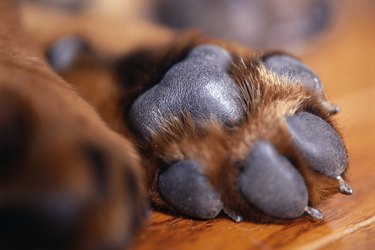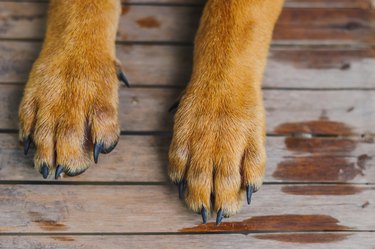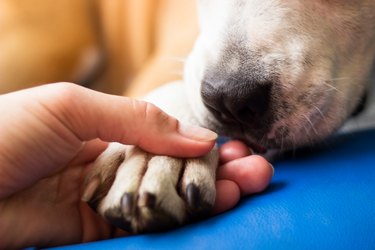Dog paw pad injuries can be quite painful for your pup. Unless the pain causes your dog to walk on three legs, they will be putting pressure on the wound and increasing the risk of infection. Healthy paw pads are critical to keep your dog sound and to protect their bones and joints. The thick, leathery skin on paw pads also protects the feet from hot and cold surfaces. If you notice your pup is limping, don't ignore it. Examine their paw pads right away to see if you can find the problem.

Video of the Day
What are dog paw pads?
Your dog's paw pads are what you might think of as the sole of your dog's foot; they are the cushy, meaty pads underneath each toe and in the middle of your dog's paw. They might be small, but they serve a pretty important role in keeping your dog's feet healthy and safe.
Video of the Day
In many ways, a dog's paw pads act exactly like a human shoe does for us. The rough skin helps to provide traction when your dog walks to help stabilize your pup and keep them from falling when walking or running. They also act as shock absorbers to keep your dog's joints protected. Finally, just like shoes do for you, paw pads help to insulate your pup's feet and keep them safe from the elements, even in particularly hot or cold weather.
Types of dog paw pad injuries
In some cases, your dog may have a thorn or similar sharp objects like a piece of glass in their paw that you can pluck out. If the thorn is small or only shallowly embedded, simply remove the object. In most cases, no additional treatment is necessary. For a larger thorn, use tweezers to pull it out and wash the paw pad thoroughly.
If the wound is bleeding, you can bandage the foot, but this is not usually necessary. If the bleeding doesn't stop, if the thorn is embedded in a joint, or if your dog starts to show signs of infection, take them to see a veterinarian for additional treatment. Symptoms of infection for which to watch include pain, swelling, heat, and discharge from the wound.
Other types of injuries could include bruising from uneven terrain or stepping on an object, burns from hot surfaces or extremely cold surfaces, cracking from dryness or cold weather, blistering from caustic substances, or rips and tears in the skin from chewing.
How to treat foot pad injuries in dogs
There are a few simple steps you can take if you notice a food pad injury in your dog.
- Clean the wound. If your pup has a minor cut, abrasion, or other wound on their paw, start by gently cleaning the wound. Remove debris if possible using tweezers. Anything deeply embedded should be left in the paw pad until your veterinarian can give your dog a sedative or painkiller before removing the debris. Disinfect the cut with betadine or by washing with anti-bacterial soap and applying an antibiotic ointment like a small amount of Neosporin. Ask your veterinarian if it is ok to use Neosporin on your dog before you use it. The American Kennel Club recommends against using Neosporin on dogs because some of the ingredients are safe and some of them are not. Neosporin is not formulated for dogs. If the wound seems more serious, it is best to bandage the paw and head to the veterinary clinic for treatment.
- Apply pressure to the paw pad to stop any bleeding. If the cut is still bleeding after 10 to 15 minutes, take your pup to the veterinarian right away, as this can be an emergency.
- Apply a bandage. Carefully wrap your dog's wound with clean, sterile gauze or apply a gauze pad to the injury and wrap it with breathable bandages, making certain that you cover all the way up to your dog's shin from the toes. You'll want to wrap tightly enough that the bandage stays in place but loose enough that it won't effect your dog's circulation or comfort. Cover the paw pad with gauze and wrap the paw with a bandage, such as a vet wrap. Check the bandage by inserting two fingers between the leg and the bandage. If your fingers don't fit, the bandage is too tight.
- Keep bandage clean. Many dogs don't like the odd sensation of a bandage on their skin, and they might try to bite or pull off the bandage. You can use an Elizabethan collar, also called a pet cone or e-collar, to prevent them from reaching the bandage or try spraying it with an anti-lick spray available at most pet stores. You'll also want to keep it dry when your dog is outside. Change the bandage daily and if you notice any changes in your dog's paw, such as swelling, odor, pus, or changes in color, or if the bleeding continues, you'll want to consult your veterinarian immediately. Cover the bandage with plastic to keep it dry when your dog goes out and change the bandage as recommended by your veterinarian.

Symptoms of paw pad injuries in dogs
While dogs aren't the best at communicating when they are uncomfortable or in pain, there are some signs that you can look for if you suspect your dog might have a paw pad injury. These include:
- Visible blood on the paw or on floors
- Limping
- Whining or crying
- Compulsive licking of the paws
- Lethargy or lack of interest in normal activities
- Discoloration in paw pads
- Resistance to walking or putting weight on the paw(s)
- Panting or other signs of distress
How long does it take for a dog paw pad injury to heal?
In general, it takes anywhere from 10 to 21 days for a dog's paw pad injury to heal. The majority of injuries' occur to the digital pads, which are the ones under the toes. The largest pad is the metacarpal pad on the front paws and metatarsal pad on the rear paw. The carpal pads are the smallest and higher up pads on the front legs. Many factors contribute to how long it takes for pads to heal, including:
- The type of injury: Is it a deep puncture wound or just surface cracking?
- The way it is treated: Are the bandages kept clean and undisturbed?
- How your dog reacts to the injury: Is your dog staying off their paws to allow for healing, or are they putting pressure back on the paw pad too early in the healing process?
- Excessive licking
Will a dog's paw pad heal on its own?
It is possible that your dog's paw pad injury will heal on its own, but it's really dependent on the type of injury your pup has sustained. If it's a simple abrasion, like a scrape or light scratch, or cracking from the elements (heat or cold), your dog's injuries may heal on their own with just a little TLC, some simple first aid, and time.
However, many injuries, even ones that appear fairly minor, could leave your dog susceptible to infections or reinjury of the paw since dogs' paws make direct contact with dirty sidewalks, floors, dirt, etc. If you notice abrasions that you think will heal on their own, it's important to keep a close eye on them and look for any changes, like bleeding, swelling, or discoloration, and bring your dog to the veterinarian immediately if you find any of these.
How to prevent dog paw injuries
To prevent paw and paw pad injuries in your dog, you'll want to take a few common-sense precautions. Never walk your dog in places that you wouldn't feel comfortable walking in sandals, such as areas with broken glass or construction debris, like nails and other metal bits or foreign objects. Also, if it's particularly cold or hot, check the surface temperature with your own bare hand before allowing your dog to walk on it.
Stay in shaded places if it's extremely hot and don't walk your dog on hot surfaces that absorb and retain heat, like sand or asphalt. If you live in a cold winter environment, consider having your dog wear winter booties to protect them from snow, ice, and cold surfaces. Also avoid excessively rough surfaces to protect your dog's paws.
Veterinary treatment for dog wounds
Dog paw pads are a difficult area to treat, but in cases of deeper lacerations, veterinary care and sutures for the injured paw will be necessary. Some situations when your veterinarian may decide to stitch the wound include deep wounds, wounds that continue to bleed, and jagged wounds.
Depending on the severity and cause of the wound, your veterinarian may also prescribe painkillers and antibiotics or advise an antiseptic ointment. During your dog's recovery, keep a close eye on the injury. If it isn't healing or if you see signs of infection, such as redness, swelling, a fever, or excessive panting, follow up with your veterinarian.
How to treat a dog's burned paw pads

Your pup may suffer burn injuries on their paw pads from walking on extremely hot or cold surfaces or walking through caustic chemicals. Sooth burns or blisters caused by extreme temperatures by soaking your dog's feet in room-temperature water. Serious burns to your dog's pads with symptoms such as paw pad discoloration and exposed tissue under the pad need veterinary treatment.
For chemical burns, rinse your dog's feet thoroughly with water, taking care not to get the chemicals on your own skin. Then, contact your veterinarian for further treatment. Your veterinarian may recommend applying an antibiotic dog paw balm or ointment and wrapping the foot.
The bottom line
Paw pads are basically the equivalent of your dog's natural shoe and offer shock absorption and protection. Since they come into contact with the ground and therefore are prone to encountering hazards, paw pad injuries and discomfort are quite common in dogs. For minor injuries, there are a number of things that you can do to promote healing and alleviate discomfort. For deeper wounds or abrasions, you'll want to consult your DVM for advice and treatment.